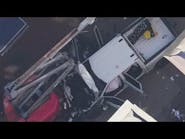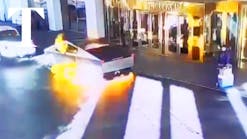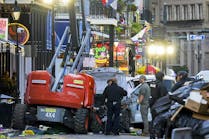Close Calls: Firefighter Trapped: Water/Dive Rescue Emergency
This continues our discussion of an incident involving the Baltimore City Fire Department (BCFD). As I noted last month, this close call provides loads of valuable information from which we all can learn, especially those of us who respond to water emergencies. Our sincere thanks to Chief of Department James Clack along with the entire investigative team, officers and members of the BCFD.
The following information was provided by Chief Clack:
The BCFD Dive Rescue (SCUBA) Team dates back to 1974, when members Frank Sappe, Bill Schulze, Ron Baker and Mike Dalton, using their own equipment, were given permission by then-Chief of Fire Department Thomas J. Burke to provide a service to the city and the department in SCUBA diving operations. In 1978, a $10,000 grant from the Baltimore City Council was used to purchase equipment. A 1969 Department of Education van was acquired and SCUBA 1 was born. All members operated on a fully voluntary basis, including training, and due to different circumstances most have since left the team. In the following years, minor purchases and maintenance costs were incurred. In 1982, approval was given to train on duty as incidents were increasing.
In 1985, a major change took place. Due to the hazards of diving in the harbor waters from pollutants, chemicals and other environmental concerns, total encapsulation of the diver became necessary. A transition from SCUBA to commercial diving equipment began. For $15,000 a system of dry operations and surface-supplied air was purchased and incorporated into the dive program. Since July 1, 1986, the team has responded to more than 1,000 calls. It also has provided maintenance service to the fireboats, performed community education seminars and assisted outside agencies such as The U.S. Coast Guard; Department of Natural Resources; federal Bureau of Alcohol, Tobacco, Firearms and Explosives (ATF); Maryland State Police; BCFD Fire Investigation Bureau; Baltimore City Police Department; U.S. Customs and Border Protection and the FBI.
Since 1992, the team has become an integral part of the makeup of the fire service. With Baltimore City’s ever-expanding waterfront properties and development, the service provided by the team finally received the recognition it justly deserves. During 10 days in March 2004, the team led the largest assemblage of agencies ever amassed to perform a marine rescue operation in Maryland. The objective was to locate and recover the victims of a tragic water taxi accident. Despite multiple obstacles, the operation proved successful and all victims were returned to their loved ones.
Personnel and equipment
The Dive Rescue Team is staffed with 14 personnel. All divers are members of the fire department and their ranks and assignments vary throughout the department. The team is equipped with advanced dive equipment. It is still outfitted with SCUBA tanks, but the primary choice for diving is surface-supplied air. Due to water contamination in Baltimore and the surrounding area, the divers use the most durable diving suit available. Viking dry suits, made by the Scandinavian company Viking, are used by military institutions throughout the world and are the primary suit worn by commercial divers. The suit is vulcanized rubber, which provides the diver with thermal protection as well as advanced protection from hazardous materials.
Baltimore City is one of the few public safety dive teams in the country that operates with the Kirby Morgan KB17B Superlite Diving Helmet. It is operated with surface-supplied air and provides thermal comfort (–31 degrees Fahrenheit) and protection from the hazards in the water. It allows two-way communications from a communications person on the dive site. The helmet is rated to 220 feet per sea water (fsw) on 21% air. The surface communications and air supply is distributed using the Kirby Morgan Dive Communications box. This is considered to be the nucleus brain center for divers in the water. Communication is vital to the success of the type of diving in Baltimore and the surrounding waters. There is very little, if any, visibility and effective communications is a critical safety feature for the diver. The box has the capability to provide communications and air to two divers operating simultaneously. It is connected to air supply tanks that transfer air though the box. The air is then distributed to umbilical supply hose that range in length from 150 to 300 feet.
The team also uses the Kirby Morgan EXO Mask. This mask is selected for rapid water entry for rescue. It can be operated on SCUBA tanks or surface-supplied air and provides communications. The air cylinders are 80 cubic feet and attached to an HMO diving harness. The harness provides lift and buoyancy for the diver. The diver also carries an extra air supply for emergency. It is a 30-cubic-foot air cylinder referred to as a “bailout bottle.” This device is used when the diver’s air supply is interrupted, providing a limited amount of air.
Experience and training
• Dive supervisor (team leader) – Captain with 16 years of fire service, 13 years of dive experience and certifications in Advance Open Water, Dive Rescue I and Dry Suit
• Primary diver – Emergency vehicle driver with eight years of fire service, 14 years of dive experience and certifications in Open Water, Rescue III International, Dive Rescue I, Dry Suit and Advanced Open Water
• Safety diver – Captain with 28 years of fire service, five years of dive experience and certifications in Advanced Open Water, Dive Rescue I and Dry Suit
• Primary diver’s tender – Emergency vehicle driver with 10 years of fire service, five years of dive experience and certification in Open Water Diver
• Safety diver’s tender – Emergency vehicle driver, 11 years of fire service, five years of dive experience and certification in Advanced Open Water Diver
• Safety Diver 90% – Pump operator with 10 years of fire service, one year of dive experience and certification in Open Water Diver
Triadelphia Reservoir
The Triadelphia Reservoir, or Tridelphia Lake, is on the Patuxent River in Howard and Montgomery counties, near Brookeville. The reservoir was created in 1943 by the construction of the Brighton Dam on the Patuxent. It has a surface area of 800 acres and average water depth of 52 feet. The reservoir is maintained as a drinking-water source by the Washington Suburban Sanitary Commission (WSSC), which provides public recreational facilities on portions of the Triadelphia property, including hiking, picnicking, fishing, boating, horseback riding and hunting.
The weather the day of the incident featured a high temperature of 60 degrees, low winds and relatively high humidity with good visibility.
Sequence of events
On Dec. 4, 2011, the BCFD was asked by the Montgomery County Fire and Rescue Department to help search for a missing boater. The boater was a WSSC employee who was presumed drowned based on information and evidence at the reservoir. Three members of the BCFD Urban Search and Rescue (USAR) arrived at the reservoir and conducted sonar operations. They discovered several targets on the reservoir bottom. That evening a member of the USAR Team who also is the BCFD Dive Rescue Team leader contacted five members of the dive team. He ordered them to assemble the following morning at Steadman Station, which houses the fire department’s Special Operations Units. The team arrived at 6 A.M. on Dec. 5. A briefing was held between the divers and team leader. The team was instructed to collect all equipment needed for the operations. All equipment was assembled and inspected, including turning on all air bottles (critical action), including the diver’s bailout bottles. The team departed for the reservoir.
The team arrived at the reservoir at 7 A.M. The two members of the USAR team had arrived at the reservoir at 6:30. They set up sonar operations and marked the targets identified the previous day. A briefing took place to include all agencies with the exception of the sonar team, which departed to search for the targets. The dive team collected all equipment that was identified and inspected it for the dive. The site was in an isolated area accessible only by boat. At this point, there was a lack of communication between unified command, the sonar team and the dive team. After an extended period, the sonar team contacted the dive team leader by cell phone inquiring about its status. The USAR member informed the dive team leader they had been waiting for an extended period for the dive team. At this point, there seemed to be an urgency to get the equipment to the site. In the rush to start the operation, equipment was left on the departure site and they had to return and retrieve the items.
The team arrived at the site and decided to conduct operations from a tree-lined shore approximately 60 feet from the identified targets. The sonar team was operating from a boat 100 to 150 feet from the shore. There are conflicting accounts as to how far the boat and diver were from shore. The team set up equipment and prepared the diver. The communications, air supply, equipment and diver were inspected and a pre-dive safety check was conducted. During that check, the diver reported he viewed his emergency air (bailout bottle) gauge, showing a reading of 2,400 psi. He then turned the knob associated with the bailout bottle on and off to show identification of its location.
The dive operation started at approximately 10 A.M. The diver went on air at 10:25, entered the water at 10:28 and reached bottom at 10:31. Two targets were searched with negative results. An order was transmitted from the sonar team to the dive communications operator to have the diver stand by while the sonar was to be repositioned to locate additional targets. The boat was moved 25 feet and the sonar was being deployed.
Shortly after the boat was moved, the diver reported he was struck by a heavy object. He grabbed the object, identifying it as an anchor. The dive communications operator requested information from the sonar team regarding an unsecured anchor. The sonar team indicated an anchor was not deployed. The diver was then instructed to start his ascent; the diver’s tender was to assist him by pulling him in. The diver then reported that he was being pulled from behind.
At this point, the diver reported he was out of air. The communications operator immediately viewed the pressure gauge on the air supply and reported no change. The diver advised he was going to his bailout bottle. The diver then reported no air coming from the bailout bottle and he was performing an emergency ascent. He dropped his weightbelt and surfaced. The recorded time the diver exited the water was 11:30. He was reported to be unconscious and cyanotic (blue, especially lips and fingers) with agonal respirations (gasping). The diver’s helmet was immediately removed by the personnel on the sonar boat. His respiration quickly increased and he gained consciousness. He was transported by a rescue boat to land and then transported to Shock Trauma Center in Baltimore.
Equipment test
As a result of the interviews conducted at the dive incident investigation, it was determined there was a need to test the air-supply system used during the incident. The test consisted of the umbilical, communication box and bailout bottle. At 8 A.M. on Jan. 29, 2012, Chief Louis R. Lago, Pump Operator Samuel Burrell, Lieutenant Kyle Caldwell and Emergency Vehicle Driver Andrew McAleer met at Baltimore City’s Steadman Fire Station. They collected the Kirby Morgan Superlight 17 Diving Helmet, bailout bottle, communication box and the damaged umbilical used in the dive incident. They assembled the helmet, umbilical, bailout bottle and communication box and charged the umbilical with air using two dive cylinders. The air pressure gauge on the communication box registered 145 psi.
The helmet’s air-supply knob was turned on and the pressure dropped to 120 psi. As the air continued to flow, a kink was made in the umbilical hose at the point of damage. The pressure gauge on the communication box increased to the original pressure of 145 psi, an increase of 25 psi. The bailout bottle was then activated and air flowed consistently into the helmet.
Contributing factors
1. The operations were to take place in a remote location. In many dive operations unforeseen circumstances arise, so it is imperative that an adequate number of personnel are assembled to handle the circumstances. The decision to only request six members from the dive team hampered operations and caused members to exceed their responsibility and span of control.
2. The sonar team did not participate in the formal briefing giving by unified command. Their participation could have addressed the issue of the repositioning of the sonar and boat. There could have been clear-cut knowledge of what each participant in the operation was doing. It is unlikely that a missed communication would have occurred between the sonar team and the dive team that caused a considerably delay.
3. Based on the lack of communication between the sonar team and the dive team, there was a considerable amount of lapsed time. Once the call was received from the sonar team, it seems there was an elevated sense of urgency and rush to get dive operations underway.
4. The dive team leader was responsible for overall operations, safety officer, documenting the dive, communicating with the sonar team, and operating the communications box and air-supply control center. His span of control was exceeded and he was unable to properly oversee his personnel. The increase in pressure on the communications box should have alerted him to a problem with the air-supply hose.
5. The dive team was unfamiliar with the new sonar equipment.
6. The dive team recently developed a new system for storage and transportation of the umbilical. It consists of wrapping the hoses in a circular pattern in a handled bucket. This has been determined to weaken the interior fibers of the air-supply hose, causing it to be more susceptible to kinking.
7. There was an early inspection of equipment at the fire station. The bailout bottle was inspected, but not bled to remove residual pressure in the hose. When the pre-dive check was conducted at the dive site, the bailout bottle gauge indicated 2,400 psi, which was the air pressure in the hose; however, the bottle was never turned back on.
8. The diver failed to properly and systematically proceed with his safety check. He checked his bailout bottle gauge and activated the knob. He should have activated the knob, then checked the gauge. Had he followed the proper procedure he would have notice a drop in pressure once he activated the knob. This would have alerted him that the emergency air cylinder was not on.
9. The primary diver’s tender failed to recognize the diver did not follow the proper procedure during the pre-dive checklist. Had he proceeded through the checklist with the diver, he would have noticed the proper procedure was not followed. He would have alerted the diver to recheck his bailout bottle. The tender is an additional safety mechanism to assure the diver is familiar with the equipment and the equipment is operating properly.
10. The boat operating the sonar was moved while the diver was in close proximity. It is unclear whether the anchor was completely retracted or was allowed to drift underwater. Possibly the boat was relocated to a deeper area of the reservoir and the anchor did not reach the reservoir bottom.
11. A review of training records indicated that many of the divers have an inadequate number of training dives.
12. The dive team should increase the number of active divers to be determined by Special Operations Command. The team should include support personnel to be trained for surface activities to include, communications, line tender, diver preparation and equipment familiarization.
13. The National Oceanic and Atmospheric Administration (NOAA) Diving Manual should be used as a guideline for the operation of the dive team.
Recommendations
1. During dive operations, the dive team supervisor should not participate in any activity associated with the dive. He should oversee all aspects of the dive operations assuring the procedures are followed. He should closely monitor all communications, assure silence during the dive, guide all operational aspects of the dive and monitor all safety checks.
2. When the Baltimore City Dive Team is activated, all members of the team who are available should participate in the operation. Dive operations become very challenging and present unknown obstacles. It is increasingly important when operations are conducted at a remote location that an adequate number of personnel are assembled to meet any challenge. This incident should have had a minimum of 10 dive personnel to assist with the operation.
3. The breathing-supply system, including reserve breathing-gas supplies, masks, helmets, thermal protection, must be inspected before each dive. For surface-supplied diving, the breathing-supply system equipment inspection includes diving umbilicals.
4. The practice of stowing the umbilical in a plastic barrel should be discontinued. The coiling caused the umbilical to become twisted tighter until the assembly kinked.
5. A complete set of standard operating procedures (SOPs) should be developed for the dive team. They should include recruitment, staffing, equipment, training and operations.
6. The pre-dive check list should include a step that requires the diver to physically turn on the bailout bottle knob and record the pressure on the gauge. The pre-dive preparation should include a document that outlines the pre-dive checklist. The primary diver’s tender would check off each step of the pre-dive safety check confirming that the proper checks are made in the correct order. This would provide a written document of the action.
7. All divers should be required to log a minimum of six training dives in a 12-month cycle. If the minimum dives are not reached, the diver will not be permitted to dive during incidents until the minimum requirement is reached. The diver will be allowed to participate on incidents as a surface technician.
WILLIAM GOLDFEDER, EFO, a Firehouse® contributing editor, has been a firefighter since 1973 and a chief officer since 1982. He is deputy fire chief of the Loveland-Symmes Fire Department in Ohio, an ISO Class 2 and CAAS-accredited department. Goldfeder has served on numerous National Fire Protection Association (NFPA) and International Association of Fire Chiefs (IAFC) committees. He is on the board of directors of the International Association of Fire Chiefs (representing the Safety, Health and Survival Section), National Fallen Firefighters Foundation, September 11th Families Association and National Firefighter Near-Miss Reporting System. Goldfeder and Gordon Graham host the free, non-commercial website www. firefighterclosecalls.com. Goldfeder can be contacted at [email protected].
THE INVESTIGATION TEAM
Baltimore City Fire Department (BCFD)
Deputy Chief Stephen Weigman (36 years of BCFD service) – Weigman has risen through the ranks, currently holding the position of deputy chief/shift commander. He has led several high-profile investigations focusing on serious incidents involving firefighter injuries.
Battalion Chief Louis R. Lago (26 years) – Lago holds an associate of applied science degree in fire science and is certified in Advanced Open Water and Dry Suit. He is a past dive team leader, leading dive operations during a 10-day, multi-agency incident involving the recovery of three missing victims who drowned at the entrance to Baltimore Harbor.
Lieutenant Kyle Caldwell, BCFD Safety Office (18 years) – Caldwell is a certified health and safety officer, incident safety officer and crash investigator. He is currently pursuing a bachelor of science degree in occupational safety and health. He is a member of the National Safety Council.
Pump Operator Samuel Burrell (26 years) – Burrell is certified in Advanced Open Water, Dry Suit and Dive Rescue Technician. He is a past dive team leader and performed several dives during the 10-day recovery of three people who drowned at the entrance to the harbor.
Battalion Chief Michael Campbell – President of Fire Officers Local 964
Firefighter Charles Hoffman– President of Fire Fighters Local 734






